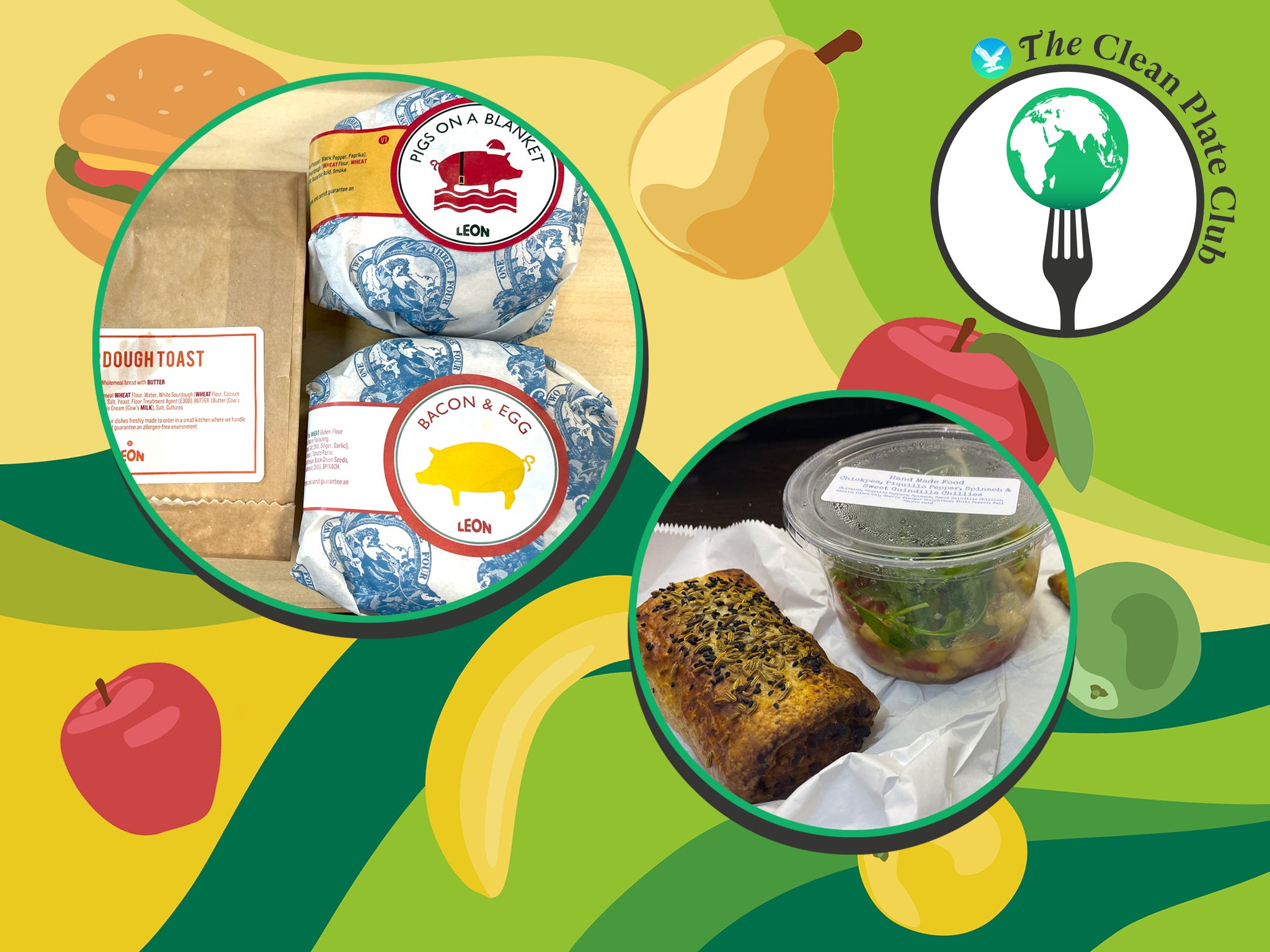I used food waste apps to feed myself for a fortnight
Can food waste apps help us make a difference? Kate Ng investigates just how much food she can rescue from going into the bin


Your support helps us to tell the story
From reproductive rights to climate change to Big Tech, The Independent is on the ground when the story is developing. Whether it's investigating the financials of Elon Musk's pro-Trump PAC or producing our latest documentary, 'The A Word', which shines a light on the American women fighting for reproductive rights, we know how important it is to parse out the facts from the messaging.
At such a critical moment in US history, we need reporters on the ground. Your donation allows us to keep sending journalists to speak to both sides of the story.
The Independent is trusted by Americans across the entire political spectrum. And unlike many other quality news outlets, we choose not to lock Americans out of our reporting and analysis with paywalls. We believe quality journalism should be available to everyone, paid for by those who can afford it.
Your support makes all the difference.Food waste is a huge global problem, with millions of tonnes of food being thrown away every year, accounting for eight to 10 per cent of greenhouse gas emissions worldwide. The Independent’s new series, The Clean Plate Club, explores what can be done about food waste as the world continues to face up to the climate crisis.
It’s been two weeks since I started using food waste apps to try and procure most of the food I eat, and things are complicated, to say the least.
On one hand, I’ve managed to stretch a bag of delicious pastries (croissants! Pain au chocolat! Danish pastry!) over four breakfasts, but on the other, I’ve been stumped over how to make a hot dinner out of a bell pepper, iceberg lettuce, bananas, and two onions I received in a mystery “magic bag” from a supermarket.
Popular food waste apps like Too Good To Go, OLIO and Karma have gained traction in recent years as the world becomes ever more aware of how the food we throw away contributes to the climate crisis. You can rescue food from participating restaurants, cafes and supermarkets so it doesn’t end up in the bin, or even share food and other items with your local community via the platforms.
The importance of Not Wasting Food was drummed into me as a young girl
The importance of Not Wasting Food was drummed into me as a young girl growing up in Kuala Lumpur, but not for the noble reasons one might think. No, when I was growing up, my parents would warn me that if I didn’t finish every grain of rice on my plate, my future spouse would be cursed with bad skin. Fearing for the poor guy, I would take great pains to finish everything I was given – whatever I couldn’t finish, or didn’t want, my father would eat while admonishing me: “Don’t waste food.”
This is not to say my family never ever wasted food, but my parents made huge efforts to throw away as little as possible. So it wasn’t until I moved to the UK that I realised just how much food waste a single person – let alone a household, let alone the estimated 27.8 million households that exist in the UK – can generate. Of course, food waste exists all over the world, but I’d never really seen people regularly leave half-eaten plates of food behind or throw out unopened packages of vegetables that still looked good but had surpassed their sell-by date until I came here.
Even more staggering are the official figures around food waste. According to food waste charity WRAP, the UK produced around 9.5 million tonnes of food waste in 2018, 70 per cent of which comes from households (equivalent to around 6.6 million tonnes). A further 16 per cent (1.5 million tonnes) is contributed by manufacturers, and 12 per cent (1.1 million tonnes) comes from hospitality and food services.
At some point, throwing away food might have seemed innocuous to the general public. After all, a lot of it is organic material, and if we don’t eat it, animals will or it will decompose and disappear into the ground.
If food waste was a country, it would have the third biggest carbon footprint in the world, after the US and China
But that couldn’t be further from the truth. The greenhouse gases emitted from mountains of rotting food, contributed by billions of people globally mean that if food waste was a country, it would have the third biggest carbon footprint in the world, after the US and China. According to the UN’s Food and Agriculture Organisation, food waste releases eight to 10 per cent of global greenhouse gases.
In the UK alone, edible food waste is responsible for 14 million tonnes of carbon dioxide emissions, which WRAP says is equivalent to the amount of greenhouse gas produced from flying from London to Perth more than 4.5 million times.
It was with these figures in mind that I embarked on my challenge to use only food waste apps to feed myself for a fortnight, without buying additional food and using what I already had in my pantry and fridge to supplement the items. It sounded simple enough and I figured it would be a good way to save some extra cash in the run up to Christmas, too. But I quickly learnt it was a little trickier that I had imagined.
As the apps are all location-based, opening them up in different places gave me different options. If I was in the office in High Street Kensington, they were almost overwhelming – should I save food from Pret, Starbucks, or Leon today? Choosing a French café around the corner to rescue a bag of the aforementioned pastries for just £5 made for four luxurious days of buttery, flaky breakfasts.

But firing up the apps in my home in south east London showed a very different story. Participating stores were fewer and far between, and often required me to walk for 30 minutes or get a bus to rescue any food I actually wanted to eat. Not a huge effort by any means, but when you can only collect the food after work, walking in the cold and dark for an hour isn’t very appealing.
But not all was lost. I paid £3.50 for a bag containing a vegetarian sausage roll, a pasty and a chickpea salad that would have cost at least that amount individually, and ate those for lunch over three days. I also rescued the aforementioned random grocery items for £4 and pulled together a taco night by diving into my freezer and digging up tortilla wraps and prawns that were languishing in the bottom drawer.

It was interesting to see what each app offered. Too Good To Go and Karma had similar models, where they connect food businesses to consumers to avoid surplus food being thrown away. OLIO was more community-minded; you can buy or borrow grocery items from people near you, and you can also post items you won’t use. Some people even give things away for free via the app. Although in the Covid era, this doesn’t feel particularly safe, I like that the app evokes a time when sharing with your neighbours wasn’t a strange thing to do.
Using the apps also made me more mindful of what I was eating and what I already had at home. For example, if I rescued a bag of bread, I might end up wasting the half a loaf I still have at home. If I picked up another bag of groceries, did I have enough staples in the pantry that I could potentially whip up a meal from?
This also made me realise there was a catch-22 involved. If I don’t rescue that bag of bread, it will likely go into the bin. But if I do rescue it, and I’m unable to eat it all before it goes mouldy because I still had bread at home, it will still go to waste. Finding a balance, as with all food shopping, is key - or we’re simply transferring the waste between one another.
My existential crisis about bags of bread aside, I do plan to keep using the food waste apps to save food wherever possible. As world leaders and policy makers grapple with how we can reverse the damage wrought by humanity on the environment, reducing food waste on a personal level can seem small and futile. But as the figures have shown, little things add up to a lot. If more people saved the bags of bread (and various other food items that might otherwise end up in the bin), perhaps it won’t seem so futile anymore. And with that, I’m off to make dinner with a rescued turnip and some rather bruised tomatoes.
Join our commenting forum
Join thought-provoking conversations, follow other Independent readers and see their replies
Comments